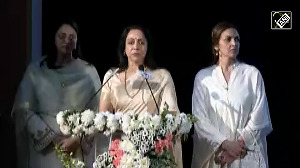Much has been said about how activities like hoarding have caused rapidly rising food prices, but analysts' studies of retail and wholesale inflationary trends suggest that it's the government's distribution system rather than speculation by wholesalers that is pushing up food prices.
Evidence for this lies in the manner in which the Wholesale Price Index (WPI) and the Consumer Price Index for Rural Labourers (CPI-RL) have risen in calendar 2009. In the build-up of inflation in 2009, high food inflation showed up at the retail level before showing up at the wholesale level in 2009. Traditionally, inflation at such high levels as in 2009 first shows up at the wholesale level and then flows to the retail level.
As the chart shows, the CPI-RL, in which food accounts for around 70 per cent, rose at a faster rate than the WPI for most of the year till September, staying in double digits for 10 of the 12 months to the WPI's eight. (Food accounts for less than half of the CPI for industrial workers, which has not risen as fast as the CPI-RL and, therefore, has not been considered here).
"I have not been able to locate any historical precedence. The retail price rise in 2009 has been higher in percentage terms than the wholesale prices, which means retail margins are going up," said Pronab Sen, the government's outgoing chief statistician and secretary, ministry of statistics and programme implementation. "Moreover, speculation has always existed and has taken place at the bulk level, and the current trend does not indicate that something is happening so much at the bulk level," he added.
There is no consensus among economists about the exact nature of the problem, but most are clear that policy-makers' explanations about food shortages as a result of poor monsoons and their focus on improving crop cycles are incorrect.
"It is a scary aspect of food inflation. Such a trend definitely points to the fact that the problem of food inflation is not as simple as tackling certain crop cycles," said Jyotinder Kaur, economist, HDFC Bank.
"The retail price situation indicates that the government has not been able to manage its distribution system. The increase at the retail level is not due to speculative activity," Kaur added.
Analysts feel that wastage and storage problems have added to the shortage of distribution channels, causing retail margins to shoot up ahead of wholesale margins. This is a particular problem at the state level, economists said.
"Distribution issues have not really been sorted out. Add in the problem of shortages and climate fluctuations and food inflation is a deeper and more complex problem," said Sumita Kale, chief economist, Indicus Analytics.
Kale added that the way the fuel economy is related to the food economy might explain why retail margins are rising.
The prognosis is that food inflation might moderate from the high levels of 17 per cent (WPI) in February as the rabi crop comes to market in April, but double-digit food inflation is going to stay.
"Today, no one is really confident that a good crop cycle will ease the pressures on a sustainable basis," said Rupa Rege Nitsure, chief economist, Bank of Baroda.






